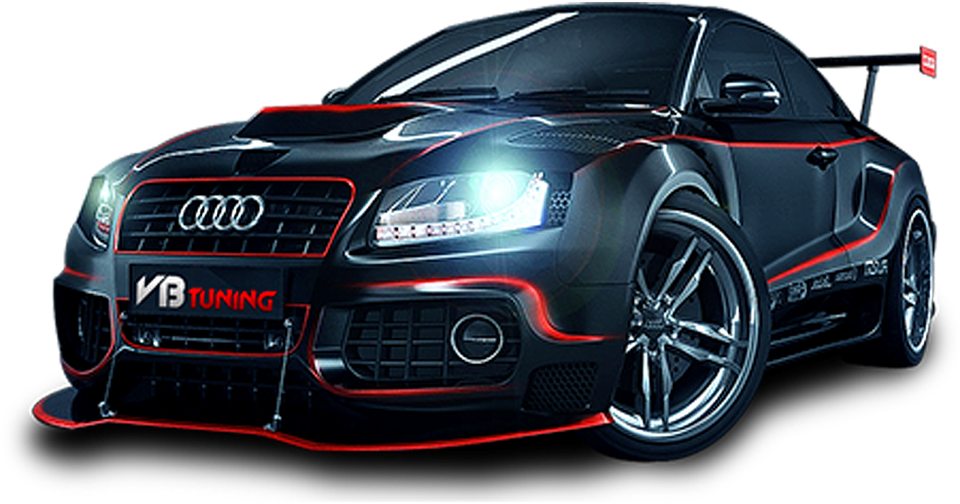The AE86 in motorsports
Shoji Nakazawa, drifting his -powered AE86
While in production, the AE86 was a popular choice for showroom stock, Group A, and Group N racing, especially in rallying and circuit races. After production ended, many private teams continued to race the AE86, and it remains a popular choice for rallying and club races today.
Part of the continued appeal of the AE86 for motorsports is its rear-drive configuration, not available in most newer lightweight coupes. In Group A touring car races, the car either dominated the lower category where eligible or fought it out with Honda Civics or the later AE92s and AE101s whilst maintaining its competitiveness. In Ireland, where rallying is considered one of the most popular forms of motorsport, as organizing regulations are more relaxed compared to that of other countries, the AE86 was popular when new, and remains so popular that teams will purchase cars from the UK due to local shortages. The AE86 is also popular for rally use in Finland, where the cars can be competitive in the F-Cup competition for naturally aspirated 2WD cars.[citation needed]
The AE86 was entered in the European Touring Car Championship from 1984 to 1988 with a 150 hp (112 kW) 4A-GEU engine.[citation needed] In 1986 it beat the BMW M6, BMW 325i (E30), Rover Vitesse, Volvo 240 Turbo, Merkur XR4Ti, Mazda 929, Holden Commodore (VK), Alfa Romeo 75 (turbo V6), and Mercedes 190E 2.3-16 to win the Manufacturers Championship with 267 points, surpassing the 1986 Drivers Championship Schnitzer Motorsport BMW M6.
The semi-factory supported Kraft team entered a spaceframe Trueno at the JGTC with a engine that came from a producing about 300 hp (224 kW) for the regulations in 1998. Despite being popular with the racefans, the car had minor success and was abandoned from use halfway through the 2001 season in favor of a newly delivered MR-S.[citation needed]
The rear wheel drive configuration, combined with the AE86’s light weight (approximately 2300 lb (950–970 kg) curb weight), balance and relatively powerful (and easy to tune) 4A-GEU engine made it popular among the Japanese hashiriya (street racers in Japanese), many of whom raced in touge (mountain passes in Japanese) where the corners suited the AE86 best, especially on the downhill. Among those who utilized this car was Japanese racing legend Keiichi Tsuchiya also known as the Drift King («Dori-Kin» in Japanese). Keiichi Tsuchiya helped popularize the sport of drifting, which involves taking a car on a set of controlled slides through corners. The AE86’s FR configuration made it well suited to this kind of cornering, and currently the car is a mainstay of drift shows and competitions. Japanese drifters like Katsuhiro Ueo, Toshiki Yoshioka, Yoichi Imamura, Koichi Yamashita, Hiroshi Takahashi, Tetsuya Hibino, and Wataru Hayashi were also involved in making the AE86 famous in the drift scene.[citation needed]
AE86s around the world have been extensively modified for use in professional drifting.
The AE86 was also rallied by several rally drivers across the world.
History[]
Use as a daily vehicle
Shinji’s late father is said to have loved the car, however it is never stated as to whether this is the same car that he used during his rally career. Mrs. Inui uses this Eight-Six as a daily vehicle, using it to transport her and Shinji through Tsubaki Line (with Mrs. Inui’s job being on the next mountain over and Shinji’s school presumably being local). Shinji started to drive his mother home from work when he was in Fourth Grade (9-10 years old), this combined with his view of the road during the morning trips (when he would be sat in the passenger seat) gave him an expert knowledge of the Tsubaki Line (similar to Takumi Fujiwara’s knowledge of Akina pass).
Sidewinder
Around a year after Shinji started driving for his mother, Go Hojo of Team Sidewinder recruited him to the team. Shinji’s skills were good enough that none of the other members of Sidewinder were able to keep up with him. Several years later, during Project D’s Kanagawa Campaign, Shinji was selected as the downhill representative for Team Sidewinder in their upcoming battle. The body of the Eight-Six was fixed up and painted prior to the battle, so that it wouldn’t be obvious to Project D that Shinji is liable to play dirty, scraping up against his opponent’s car. Initially not wanting to race in his battle against Takumi Fujiwara, he later changed his mind after watching the battle between Keisuke Takahashi and Go Hojo with Mako Sato and Sayuki.
Vs Takumi Fujiwara
As the race begins, Shinji amazes Takumi with the sheer speed of his car. After maintaining the lead for a while, Shinji pulls over, allowing Takumi to overtake him. Takumi struggles to pull ahead of Shinji, shocked by his act. Shinji manages to overtake his opponent again whilst they are in an S-shaped corner by bumping up against Takumi’s Eight-Six. Shinji was shocked by Takumi’s ability to keep up with him in the corners, which threw off his concentration. During this lapse of focus, Takumi managed to perform a blind attack, overtaking a shocked Shinji. Shinji exploits the loss of grip in Takumi’s tires, allowing him to overtake him in a turn. In a last ditch effort to overtake, Takumi performs a blind attack. Takumi turns his headlights on as he pulls ahead, however due to him revving his car at 12,000RPM, his engine explodes, sending the two cars into a spin. Whilst Takumi spins 180° and crosses the line in reverse, Shinji spins a full 360°, costing him a large amount of speed and losing him the race.
The Classic Design Of Toyota Trueno
As for the second version, Trueno is most identified with AE because of its distinctive, retractable headlamps. Leather seats are available on some models. It’s a positive thing if you come across a vehicle with a respectable interior. The driver’s cab is spacious and pleasant for a driver and a passenger.
1. Great Outlook
The inside of the Toyota Trueno AE86 has air conditioning, a radio, and one cup holder in the middle of the dashboard on some models. The storage room is limited. However, each door has a jacket pocket that will come in handy. Ask any AE86 admirer now what makes the car so unique, and they won’t simply say the layout. Admittedly, the chassis was essentially carried over from the prior years, when all body types were RWD.
2. Under The Hood Of The Toyota Trueno
In the normal configuration, the Trueno featured a maximum power output of 128 HP at 6,600 rpm and torque of 149 Nm at 5,200 pm. But, it was eventually down-rated to 118 HP and 142 Nm in total output.
Дизайн
Машина выпускалась в разных кузовах (в том числе и трехдверный хэтчбек), но наибольшую популярность получило именно купе. Машина имеет гармоничный облик. Дизайн характерен для 80-х – рубленые формы, квадратные фары и минимум экзотики. Это максимально простой и доступный автомобиль. Кстати, некоторые версии имели «слепую» оптику. Бамперы не красились с завода, однако часто на «Тойоту АЕ86» устанавливают модные обвесы и «губу», делая ее еще более аэродинамичной. Колесные арки позволяют уместить любые колеса. А поигравшись с развалом, можно вступить в ряды «стэновых» машин. Смотрится этот автомобиль на классических дисках очень эффектно.
Iketani is the S13, and the S13 is Iketani
In some ways, Iketani’s story in the show is quite like that of the S13. While the S13 is an iconic drifting car, and is held in high esteem by the more experienced aficionados of the sport, it is perhaps under-appreciated by some, who see it merely as the older member of the S-Chassis family.
Similarly, Iketani is somewhat underappreciated in the group, even though he is captain of his own team.
Having such an iconic car and being captain of a team were never enough to win over his beloved Mako, nor were they enough to propel him into any kind of wealth or success in the future.
By very late in the series, we discover that Iketani is unmarried, balding and still working at the gas station.
At least he never lost his passion for cars!
The debate between the S13 and S14 has gone on for a long time, whether it’s about the Silvia, or the 180SX, 200SX or 240SX, these cars seem to have a unique ability to spark lively debate.
Those of us in the know are aware that there is much to love about the Silvia S13, just as there is much to love about Iketani.
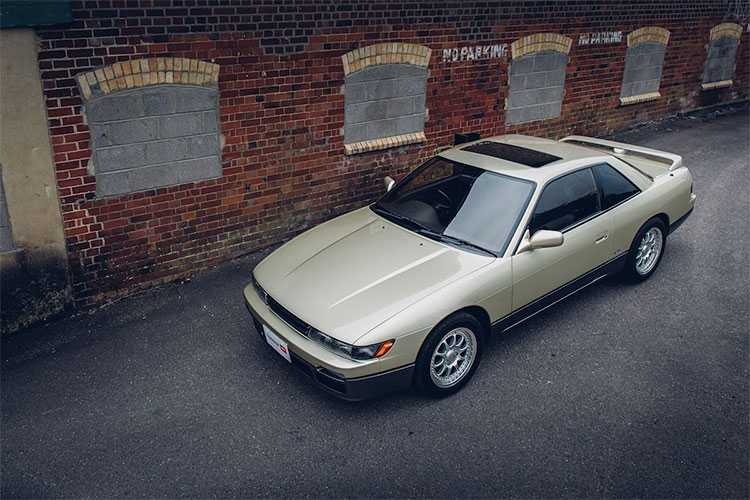
Toyota Corolla AE86 в поп культуре и дрифте

Toyota Corolla Levin на кольцевых соревнованиях
В конце 1980-х в Японии зародился новый вид нелегальных уличных гонок под названием дрифт. Зачастую они проходили на горных серпантинах, повороты в которых проходились в управляемом заносе. В подобных условиях заднеприводная 86-ая с блокировкой межколесного дифференциала показывала себя великолепно. Кроме того, практически идеальное распределение веса (53% на передней оси и 47% на задней), делало Хачироку идеальной машиной для дрифта. Пустить AE86 в идеальный занос было не просто, но тем кому это удавалась впоследствии достигали в дрифте небывалый высот. К примеру непревзойденный мастер дрифта Кэйити Цутия, начинал именно с 86-ой. Он настолько проникся к ней уважением, что называл Хачироку не иначе как королевой дрифта.

Кадр из аниме Initial D, где главный герой участвует в гонках на Спринтер Труено АЕ86
Однако ошеломительный взлет популярности Toyota Corolla AE86 произошел не из-за дрифта (хотя без него и не обошлось). В 1998 году в Японии вышел анимационный сериал Initial D повествующий о нелегальных гонщиках — дрифтерах. В нем главный герой Такуми Фудзивара днем занимался доставкой, а вечером участием в уличных гонках на Хачироку
Анимэ стало очень популярным в Японии и привлекло повышенное внимание к машине главного героя
Как следствие, рост популярности АЕ86 немедленно отразился на ее стоимости. После выхода сериала, цены на машину с каждым годом росли достигнув совсем уж не приличных значений. Этот феномен получил название «налог Такуми».
In popular culture
Initial D AE86 replica.
The main character of the anime and manga Initial D, Takumi Fujiwara, uses his father’s AE86 Trueno GT-Apex Hatchback for racing and making his tofu deliveries. Also in Initial D, Takumi’s friend, Itsuki Takeuchi, drives an AE85 Levin, initially mistaking it for an AE86. Later on in the series, an imposter Takumi drives his own AE86 Trueno – although it is a Kouki (late model) instead of a Zenki (early model). Throughout the series, two of Takumi’s opponents would drive AE86s, the first being Wataru Akiyama, who drives a turbocharged (later converted to supercharged) AE86 Corolla Levin and Shinji Inui, who drives the Notchback coupe version of the AE86 Trueno in the series’ finale. A Corolla Levin AE86 also made a brief cameo in The Fast and the Furious: Tokyo Drift and Fast and Furious 4.
The popularity of the manga is cited as the main cause of the car’s high resale price, which is often referred to as «Takumi tax» or «Tofu tax», after the main character and his tofu delivery occupation.
The Sprinter Trueno and Corolla Levin are featured in the racing video games series Gran Turismo and Forza Motorsport (excluding the Corolla Levin), Sega GT, Tokyo Xtreme Racer for the Sega Dreamcast (which was later made to PS1 & PS2 for other TXR titles), Grand Theft Auto IV and Grand Theft Auto V as the Karin Futo (based on the Corolla Levin). A modified AE86 Trueno similar to the one depicted in Initial D (starting with Gran Turismo 3: A-Spec) appears only in Gran Turismo. The American market AE86 GT-S is featured in Need for Speed: Underground 2, as a starter car. The Toyota AE86 also appears in Need for Speed: The Run, for challenges and multiplayer events. It also appears in Need for Speed: World, Need for Speed: Pro Street, and Need for Speed (2015) (GT-APEX) and Need For Speed: Carbon, and Need For Speed: No Limits. It also appears in the Taito Battle Gear arcade and console racing game franchise. In Battle Gear 3, it appears in tuned and stock forms—the S-Class Trueno appears as a mechanically-tuned machine, while the S-Class Levin appears in both turbocharged and supercharged versions, both looking similar to their Initial D counterparts. The Toyota AE86 Trueno also can be used in Japanese pack of Assetto Corsa. In the Wangan Midnight arcade game by Namco (starting from Maximum Tune 4), it appears with a stock tune of 130 hp and a stock body in the beginning with some 3 selectable colors, and it also appears in anime and manga of the same series as a traffic car.
Why are we so interested in Iketani?
Well, in short, it’s because of his car that he drives as leader of one of the local street racing teams, the Akina Speedstars. That car is, of course, a Nissan Silvia K’s (S13).
Iketani-san leads his team as they spend their free time racing on their home course, Akina. In the early “stages,” Iketani appears in almost every episode, but his role does seem to taper somewhat in the later stages of the series.
To a JDM and 180sx enthusiast, there can be no other character in the show who should garner more of our attention than Iketani, who clearly has both the best taste and the greatest confidence in his own ability.
As we all know, the S13 is the car of choice for the switched-on drifter. Beginners are more likely to opt for the S14 (a car that Iketani is not keen on at all), which is more conducive to those learning and mastering the techniques.
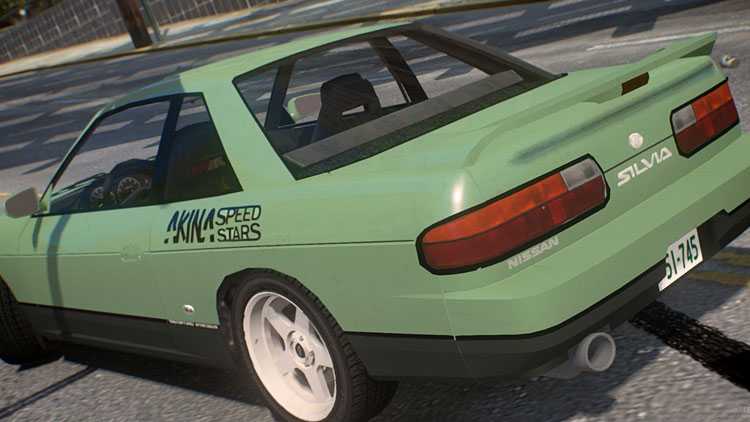
Takumi’s Initial D AE86 in Games
Have you ever wanted to get behind the wheel of Takumi’s AE86 before drifting your way through the tight and technical Japanese touge roads?
There are plenty of games out there that can provide precisely this!
For us, the ultimate choice is Assetto Corsa, and you can appreciate the game in its 4K goodness in this video.
Thankfully, Assetto Corsa is the most mod-friendly game drifting game available, but you’ll want to ensure you get the PC version if you wish to drive Takumi’s Eight-Six, as the console editions don’t allow mods.
If you wish to download the Assetto Corsa mods, then head to the description on this YouTube video, where you’ll find everything you need to know.
Not only can you drive Takumi’s AE86 in its final, high-powered Project D form, but you’ll also have a choice of the following Initial D cars.
- Honda Civic SiR EG6 (Shouji Shingo)
- Mazda RX-7 FC (1st and 5th Stage, Ryosuke Takahashi)
- Mazda RX-7 FD (1st, 2nd and 5th Stage, Keisuke Takahashi)
- Mitsubishi Lancer Evolution III (Kyoichi Sudo)
- Toyota Sprinter Trueno GT-Apex AE86 (2nd Stage onward, Takumi Fujiwara)
There’s also a selection of challenging touge roads for your satisfaction:
- Mount Akina 2017
- Irohazaka
- Mount Myogi
- Akagi Mountain Pass
- Shomaru Pass
Once you’ve got your mods, you may want to take your experience to the next level by opting for a GPU upgrade for your PC so that you can enjoy the incredible VR potential that Asseto Corsa has to offer.
It’s also possible to find mods for Takumi’s car in GTA V, or you can download a custom livery in Forza Horizon 4 or Need for Speed Payback.
Alternatively, if you’re desperate to get behind the wheel wherever you go, then mobile drifting games such as FR Legends will provide a fantastic alternative.
If you want the most incredible possible Initial D gaming experience, you’ll need to get yourself to Odaiba, Japan. Life goals!
Хачироку
Toyota Corolla Sprinter Trueno предлагался как в двух так и трехдверном кузове
Новая модель под индексом AE86 была основана на платформе Corolla TE71 предыдущего поколения. Под руководством талантливого инженера Нобуаки Катаямы, специалисты немного обновили шасси: модернизировали подвеску и установили дисковую тормозную систему. Но главное, под капотом АЕ86 прописался передовой двигатель нового поколения — 4A-GE. Это первый четырехцилиндровый мотор японской компании с четырьмя клапанами на цилиндр и двумя распредвалами (DOHC). Кроме того, он был оснащен инновационной системой изменения геометрии впускного коллектора T-VIS и инжекторной системой питания.
Двигатель 4A-GE
Двигатель 4A-GE мощностью 124 л.с. обладал «крутильным» характером с красной зоной на отметке 7400 об/мин. Вдобавок мотор обладал очень большим потенциалам для доработок и высокой надежностью.
Салон АЕ86 не отличался особым изыском, но никого из водителей это не волновало
Toyota Corolla AE86 получилась легкой и быстрой машиной. Журналисты отмечали, что на ходу Хачироку ощущается намного более мощным автомобилем, а за острое и точное рулевое управление прозвали машину: «200-сильный карт». Кстати прозвище Хачироку, автомобиль получил за свой индекс: на японском число 8 звучит как «hachi», а 6 как «roku».
Beyond the series
The Manga and TV series also helped to inspire a slew of video games which have been developed and played well into the present day. The first game was Initial D Gaiden (1998) on the Game Boy.
The latest installation was the Initial D Arcade Stage Zero arcade game which emerged in 2017. The arcade game series are arguably the most successful commercially, and give players the chance to feel more like they are driving the cars themselves, which adds to the experience.
There was also a live-action film released in June, 2005, which outrageously was made without including Iketani as a character. His role as leader of the Akina Speedstars is somewhat usurped by Itsuki Takeuchi.
Takumi is played by uber-famous Taiwanese pop idol Jay Chou. The movie was not well received by critics, and an elusive sequel remains in the rumor mill to this day.
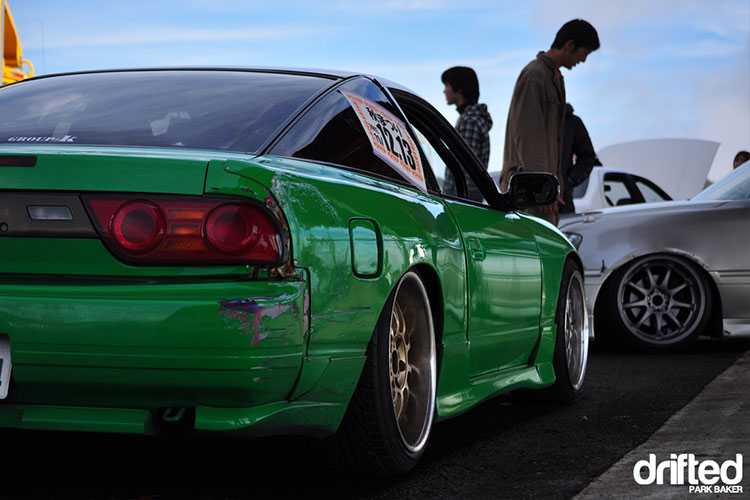
Интерьер
Салон «Тойоты АЕ86» — классика 80-х. Японцы любят использовать велюр. Он здесь везде – начиная с ковриков, заканчивая отделкой дверных карт и задней полкой. Тем не менее данный материал очень износоустойчив. Руль находится справа. Панель приборов имеет две основные шкалы – спидометр и тахометр. На версиях с АКПП также дублировался режим (драйв, паркинг и т.д.). Машина лишена какого-либо комфорта – это чисто кольцевой автомобиль. Здесь нет климат-контролей, электрических стеклоподъемников и прочих «наворотов». За это и любят дрифтеры «Тойоту АЕ86». Ведь при минимальных переделках ее можно превратить в настоящий «корч».
Without doubt, Initial D made a JDM cult hero out of the Toyota AE86
The final episode of Initial D aired in 2014. Throughout its six-year cycle, the show had been described by critics as “the best show I’ve seen in a long time” and applauded for being generally “done well.”
Without any doubt, Initial D’s biggest imprint on JDM car culture was the role it played in creating a cult hero out of the humble AE86. Since the show went off air seven years ago, prices of the boxy, Toyota coupé have skyrocketed.
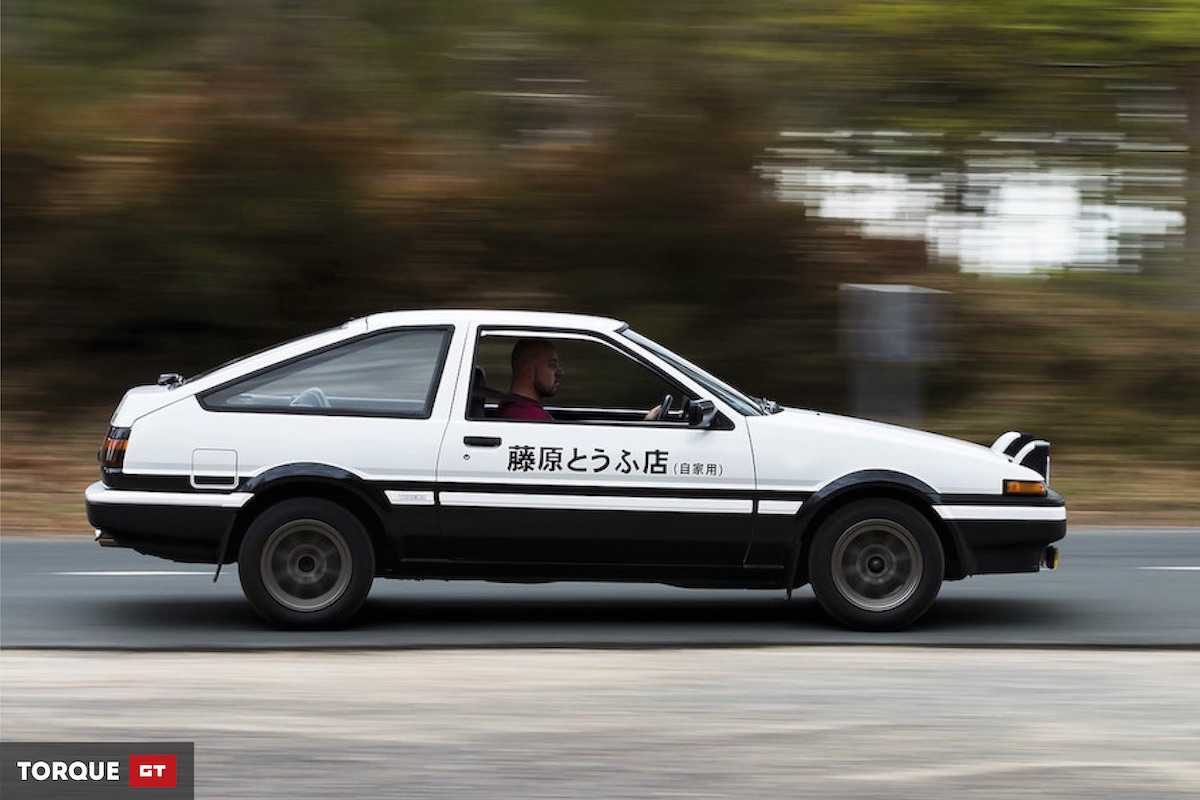
Initial D has inspired plenty of Takumi-inspired Toyota AE86 liveries worldwide, but be prepared to pay BMW M5 money to get your hands one one
The increase in Toyota AE86 prices is known amongst as the “Takumi Tax” thanks to the car’s giant-killing performance on the big screen, and fans of Initial D have scrambled to buy their very own version of the easily-driftable AE86 to emulate Takumi.
In recent years, the asking price for a well-used (see, well-drifted), high-mileage Toyota AE86 on the United Kingdom’s classic car market would start at around £15,000. Meanwhile, a barely-used, well-maintained car, can easily achieve over £35,000.
It is also estimated that a handful of Toyota AE86s exist in the UK today. As-per supply and demand economics and the UK’s current booming classic car industry, it is expected that they will only increase in value during the coming years.
The author of this piece, Dominykas Liberis, is an automotive photographer and photojournalist based in Vilnius, Lithuania. To check out his work, follow his photography page here.
If you are interested in owning one of these increasingly rare JDM icons, head to Dyler to find your Toyota AE86 today.
—
History Of Naming The Toyota Trueno
The Toyota Sprinter Trueno AE86 generation is a compact, lightweight coupe or hatchback that was released by Toyota in 1983. It was a part of their fifth-generation Toyota Corolla series. In Japan, the AE86 was also called the ‘Hachi-Roku.’ Hachi-Roku is Japanese for ‘eight-six.’ So it is the car number translated in Japan.
Not The First Naming Attempt
This wasn’t the first instance for Toyota to follow this number-translation naming strategy. The AE85 was named ‘Hachi-Go’ in the Japanese market, which translates to ‘eight-five.’ For the sake of simplicity, the insider-chassis code “AE86” represents the range’s 1600 cc RWD model.
The Popularity Of The Toyota AE86
What makes a car popular? Its excellent service, exquisite design, dependability, and so on. Sometimes, cars can be famous thanks to some external factors as well. For instance, being referenced in pop culture can make a car gain tremendous popularity. This is the case for the Toyota Trueno.
The AE86 was influenced by Japanese racing driver Keiichi Tsuchiya’s automobile. Tsuchiya was a muse as well as an overseer for Initial D. Many of the changes on the Initial D car, including the TRD carbon-fiber bonnet and Fujitsubo exhaust, were identical to Tsuchiya’s actual vehicle.
There is one person responsible for hoisting the AE86 into the popular consciousness. His name is Keiichi Tsuchiya, and he is also known as the “Drift King.” He was a rogue racer. Keiichi saved money for his Toyota Corolla Trueno in the mid-1980s by working numerous jobs. He worked throughout the day and improved his driving abilities at night while holding the keys. His preferred stomping grounds are Japan’s highland highways.
Iketani’s S13 in action
While the “star” of Initial D is nearly always Takumi, we do get to see action from Iketani and his S13. In the earliest episodes, Iketani is introducing Takumi to his team and to the thrilling world of speed racing on the Akina circuit.
The first and only dedicated “battle” is we get to see with Iketani and his customized S13 is an impromptu one shown in the 11th episode of Initial D: First Stage, which first aired in 1998.
The episode, entitled “Shingo Arrives!” depicts a night in which Iketani takes a drive out in his beloved S13 to practice a new technique he has picked up from Takumi, only to be ambushed by the very sinister Shingo.
Shingo is a member of a rival team, the Night Kids, and is infamous for his dirty tactics and his car, a red EG-6.
During the impromptu battle, Itekani’s Nissan S13 is bumped from behind. Our friend Iketani knows that this was no accident, and so he takes immediate evasive maneuvers to try and lose Shingo.
Unfortunately, the underhand tactics of Shingo win the day and poor Iketani is sent flying into a 360-degree spin, only to be then ridiculed by Shingo.
Of course, it’s easy to mock when you haven’t been racing with honor!
Iketani is also known in the show for his particular skills with his S13, namely:
- Unique corner entry skills, which are especially and positively remarked upon by the “guys from Tokyo” who drive the Nissan S15
- E-brake (handbrake) drifting, which is a technique in which the handbrake can be used to extend a slide while simultaneously slowing the car down at the same angle
- Heel-and-toe drifting, a technique that allows drivers a smoother downshift
Open Box of CADA C61024 Toyota AE86 Hachi-Roku
The box had the Initial D 頭文字D logo and the anime character Takumi Fujiwara to grace the cover. The part counts are 1324 pieces with recommended age of 8 and above. Seeing the wording 藤原とうふ店 on the car model brings lots of smile on our faces. Finally we don’t have print our sticker to make the anime version of AE86.

You could build the Project D version of the AE86. This is after Takumi had blown the engine and made the upgrade.
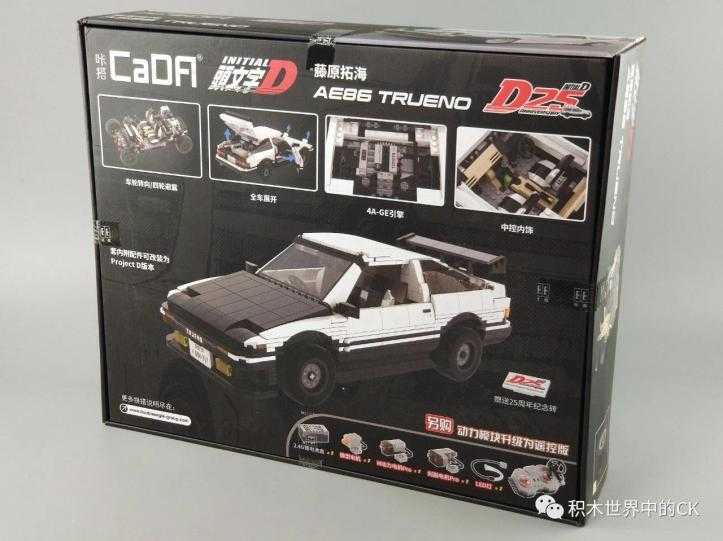
There are two inner boxes with the illustration by Shuichi Shigeno, the author of Initial D. We can’t bear to throw away the boxes.
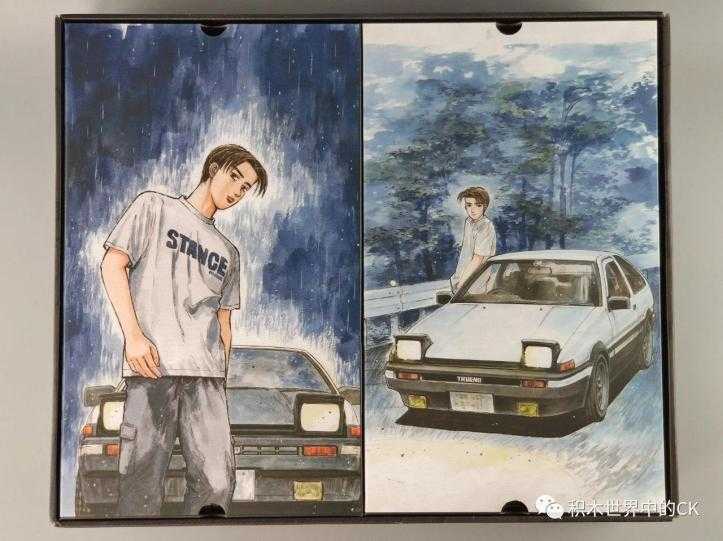
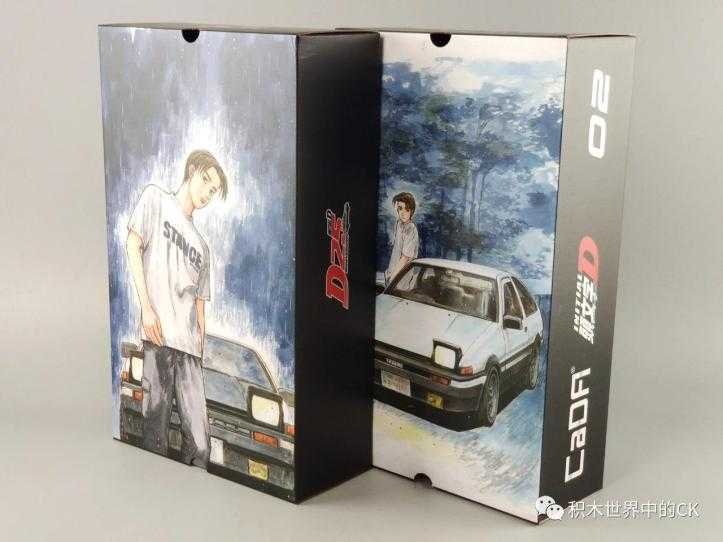
The manual and the stickers are packed together.


More illustration found inside the manual.

You could upgrade the car to RC version by buying extra components such as power functions etc.

High quality stickers with reference to the anime. The characters 藤原とうふ店 are what we really after. Previously CADA released C61019 back in 2020 that is licensed by Toyota but no IP from Kodansha hence no reference could be made to the anime. When you order CADA C61024 from Aliexpress make sure it’s the right version with Kodansha IP.

The numbered bags are standard feature for clone bricks makers these days.


1985 Toyota Sprinter Trueno GT Apex (AE86) [Add-On | Tuning | Template | Livery | RHD | Pop-up Headlight] Final
All Versions
23 116 загрузки , 37,7 МБ 5 января 2021
408 загрузки , 37,4 МБ 4 января 2021
67 загрузки , 37,1 МБ 3 января 2021
58 загрузки , 37,3 МБ 2 января 2021
927 загрузки , 37,3 МБ 31 декабря 2020
265 загрузки , 37,1 МБ 31 декабря 2020
345 загрузки , 30,7 МБ 30 декабря 2020
242 загрузки , 28,9 МБ 28 декабря 2020
607 загрузки , 34,2 МБ 27 декабря 2020
548 загрузки , 59,9 МБ 25 декабря 2020
364 загрузки , 53,1 МБ 24 декабря 2020
227 загрузки , 52,5 МБ 24 декабря 2020
290 загрузки , 52,2 МБ 22 декабря 2020
484 загрузки , 51,0 МБ 21 декабря 2020
63 загрузки , 51,0 МБ 21 декабря 2020
659 загрузки , 47,2 МБ 18 декабря 2020
41 402 загрузки , 59,4 МБ 19 июля 2018
3 775 загрузки , 56,6 МБ 6 сентября 2017
More mods by FreedomGundam:
- Автомобили
- Lamborghini
- Add-On
- Add-On
- Автомобили
- Mazda
- Add-On
- Автомобили
- Mazda
- Add-On
- Mazda
- Add-On
- Автомобили
- Toyota
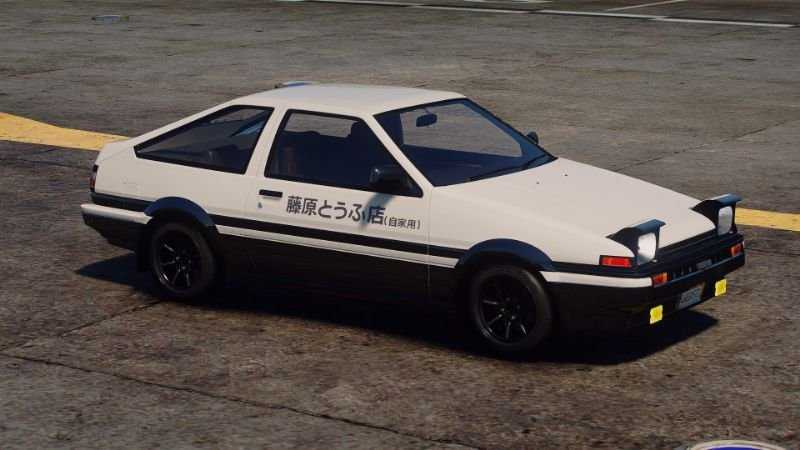


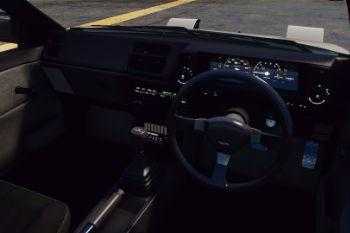
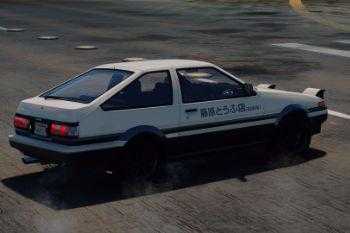
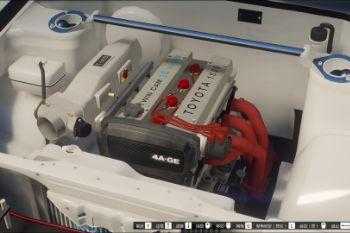


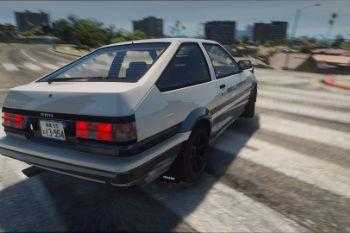




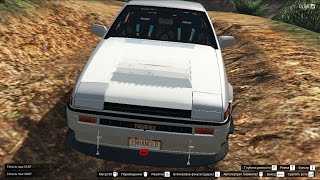




1985 Toyota Sprinter Trueno GT Apex(AE86) Pack Edit & Convert: FreedomGundam Fix: Rasputin Model from: Grand Theft Auto San Andreas/Forza Motorsports 4
In-Game Automatic Pop-up Headlight ready! Don’t need script and Lua any more! But the game version need 1.0.1032.1 or above. Private version game can update to 1.0.1180.2.
Wanna Watanabe RS wheel (Initial D one)? Go to download: JDM Rims Pack
Notice: If you find out any bugs of this car, please let me know. Thank you!
14.7.5: Fixed bugs. Changed a tuning bumper.
14.7.4: Deleted some meshes. Changed some colors.
14.7.3: Changed a tuning front bumper.
14.7.2: Breakable glasses. Fixed bugs.
Happy New Year!!
14.7: Added emblem on bodyshell. Fixed a bodyshell problem.
14.5: Updated transmission model and suspension model. Changed material of bodyshell. Fixed two doors problems. Renewed doorsills. Adjusted angel and position of Pop-up headlights rotation. Changed material of stock exhaust.
13.8: Added transmission. Fixed plate size of tuning bumper.
13.7: Resized files again, deleted some useless meshes. Fixed taillights problems. Added suspensions.
13.6.5: Added hood shaft and door shaft. Arranged textures of lights cover. Repacked textures file, deleted useless textures.
13.6.1: Fixed size of two small foglights on front bumer. Changed material of taillights and brakelights fragments. Changed engine to real 4A-GE 16-Value Engine. Improved trunk side.
13.5: Fixed headlights’ textures glitch when these are broken. Fixed taillights and brakelights. Added a non-interior detail front bumper (same with the second tuning front bumper). Added two small fog lights on the second tuning front bumper. Added two more tuning cage.
13.3: Added interior light. Improved trunk.
13.1: Added two small foglights on the front bumper. Added a small light on two sides of car. Added a trunk. Fixed inner detail of headlights.
12.1: Fixed steering wheel’s position.
12.0: Added inner details of headlights. Added nine extra tuning parts.
11.3: Changed textures. Changed suspension hardness. Deleted tunning wheels folder
11.2: Lower car’s acceleration. Something else, I already forgot.
11.1: Re-adjust headlight angle when it open Change suspension Change wheels position Change size of wheels
11.0: Automatic Pop-up Headlight ready!! Reconvert No.21 wheel
9.9: Fix engine room color Fix bonnet color Delete useless materials
9.6: Fix bodyshell material add a tuning wheel
9.5: Set Headlights as trunk Change 4A-GEU texture Change 4A-GEU position Remove Replace version
Change diameter of wheel size Fix whole car’s texture Add a tuning wheel (Initial D version wheel) Change engine Add detail on bonnet Add detail on trunk Fix suspension
8.0: Fix doorsills Fix diameter of four wheels Cancel the trunk Update FM4 replace version Update new suspension Delete replace version of GTA SA
7.8: Fix Addon version car’s doorsills Fix Addon version car’s wheels size Update liveries
7.5: Update RHD Animation of AE86 in addon pack Remove San Andreas’ Trueno from addon pack
7.1 Fix addon pack AE86’s suspension Move four wheels position Add Engine Cooling system in the car
7.0 Add AE86 headlight always open replace version
6.8 Fix wheels position
6.7 Add livery Fix AE86’s wheels’ diameter size
6.6 Fix AE86’s bottom has light problem Make AE86’s four wheels’ diameter a little bit bigger Make AE86’s suspension a little bit higher
6.1 Add template
6.0 Fix some problems which on the AE86 (Fix by Rasputin) Fix bumper 2 Add two liveries
4.0 Fix dials’ color Remove two front mudapron behind two front wheels for Forza 4 AE86 Add several extra tuning parts for Forza 4 AE86
2.8 Change size of tuning wheels of Forza 4 AE86 Change color of tuning bumper
Комплектация
Самые популярные комплектации с мотором 4A назывались GT, GT APEX, GTS и GTV. Последняя кроме всего прочего обладала жёсткой подвеской, короткой рулевой рейкой и блокировкой дифференциала. Кстати, комплектация GT APEX окрашивалась в два цвета, как правило, в черный и белый. Поэтому ей дали милое прозвище «королла-панда».
Такая особенная машина очень скоро стала постоянным участником спортивных соревнований. Невероятно хороша Toyota trueno 86 была на заносах. Все характеристики, все особенности вроде заднего привода, механической коробки передач, оптимального соотношения мощности и массы модели, отлично подходили для быстрой езды не только по японским горным серпантинам, но и по спортивным трассам всего мира. AE86 наряду с подобными ей моделями стала не только символом, но и поводом для появления и развития такого эффектного вида спорта, как дрифтинг.
Кроме дрифтинга toyota ae86 подняла на новый уровень и японский кольцевой чемпионат. На базе этой модели создавали отличные болиды. Также машина отлично вела себя и в других соревнованиях на скорость, вроде того, когда два авто стартуют по извилистой дороге до тех пор, пока один из соперников не опережает другого.
Shifting From Mountain Passes To Television
Because of its RWD configuration, lightweight nature, and well-balanced setup, the Toyota AE86 was a favorite among private teams competing in stock and group racing categories. It was also popular among Japanese street racers (hashiriya) who loved challenging mountain passes (touge) with their awe-inspiring drifts. The AE86 was further popularized by pro-racer Keiichi Tsuchiya, who is also known as the Drift King.
While the AE86 was already a star among groups of racers and drivers, it was just another car for the larger public. But that changed in 1995 when Shuichi Shigeno’s street racing manga – Initial D — was serialized in Weekly Young Magazine. Initial D was then adapted into an anime series of the same title in 1998. Initial D, essentially catapulted the AE86 into stardom status.
Initial D, and bringing racing knowledge from Japan’s ‘Drift King’ to the masses
Without giving too much away, the premise behind Initial D is simple. Its main character, student Fujiwara Takumi, spends his evenings delivering takeout dishes for his father, a retired, chain smoking race driver, who now owns and runs a tofu shop in Japan’s Gunma prefecture.
The black-and-white AE86 driven by Takumi is his father’s old drift car, and it’s the 17-year-old’s ballsy heroics behind the wheel of the light yet-modestly-powered Toyota that lead to Takumi being introduced to the local drift scene and the world of illegal street-racing.

Initial D in one sentence would be “a kid in an old Toyota AE86 beats everyone on the downhill”
In both the manga and real worlds, these were known as Touge races and they were held on Gunma area’s twisty, mountainous roads. In the comic, Takumi would take on much newer, and vastly more powerful, iconic JDM classics such as the Nissan Skyline R32, Subaru Impreza WRX STi, and the Mazda RX-7.
Thanks to a high-revving, twin-cam motor and almost-perfect 50/50 weight balance, the small-yet-nimble, 970 kilogram Toyota with Takumi at the wheel would often emerge victorious.
Takumi’s gutsiness behind-the-wheel of his AE86, and the simple premise that an ageing, cheap, underpowered car could outperform bigger, faster, machinery in the right hands, gave JDM and drift fans across the world that one day, they could emulate their hero.
By 1998, Initial D’s popularity had grown to such an extent, that it made the transition from the pages of the manga comic to the TV. The Initial D anime series was born, and fans could tune in to watch Takumi and his Toyota AE86 give household JDM names a thorough pasting, week-in, week-out.
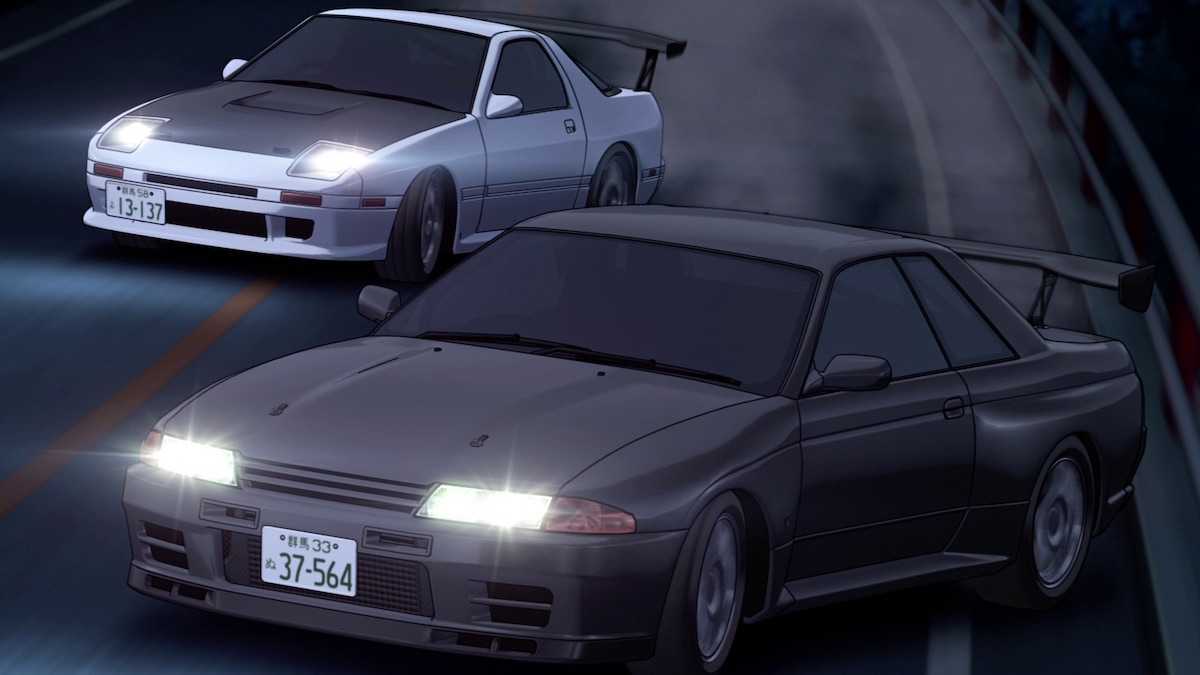
Initial D was packed to the hilt with JDM classics including the Mazda RX-7 (left) and the legendary Nissan Skyline GTR R32 ‘Godzilla’ (right)
Alongside the overall tale of derring-do, Initial D’s producers hired local race driver Keiichi Tsuchiya who was mentioned earlier as a consultant. The former drifting champion and Le Mans podium-finisher shared his racing know-how to show what makes a successful racing driver to the TV screen, albeit in cartoon form.
With Tsuchiya’s insights, Initial D touched on everything from steering inputs and heel-toe shifting, to the science behind tyre wear and weight transfer. The show’s racing sequences were also dubbed in order to explain to aspiring Takumis what was happening on screen, and what they would need to do to emulate their hero on a race track.
Toyota Trueno AE86 Vs. GT86
1. Interior
While being the smallest petite four-seater sports car on the market, the Toyota GT86 is not claustrophobic in the interior. Toyota, on the other hand, has smartly built the inside to be pleasant, well-equipped, and, most notably, driver-focused.
The contoured cloth seats are set low, which is important for keeping a low center of gravity and giving passengers a sporty sensation, and the tiny steering wheel and quick, short-throw gearbox are coated in buckskin leather that’s a pleasure to grasp. LED daylight running lights assist with visibility on the road, while high flash headlights guarantee the driver can see the road well at nighttime.
